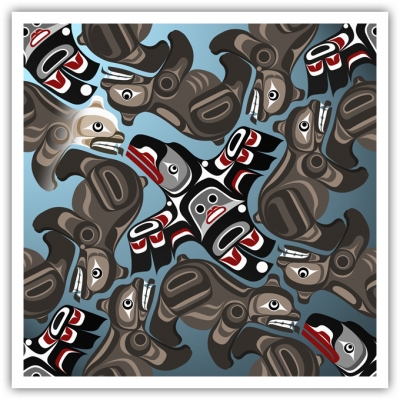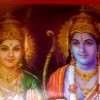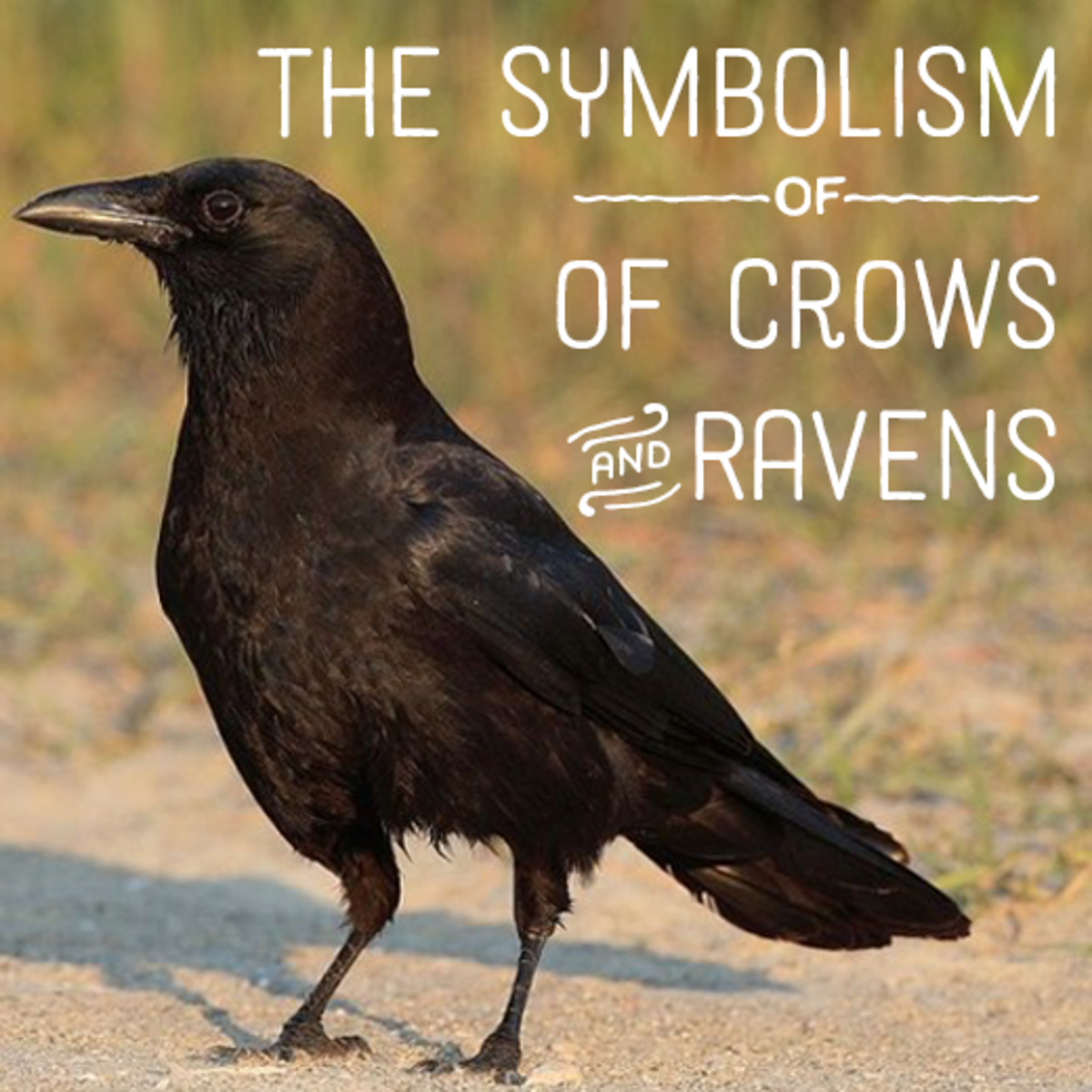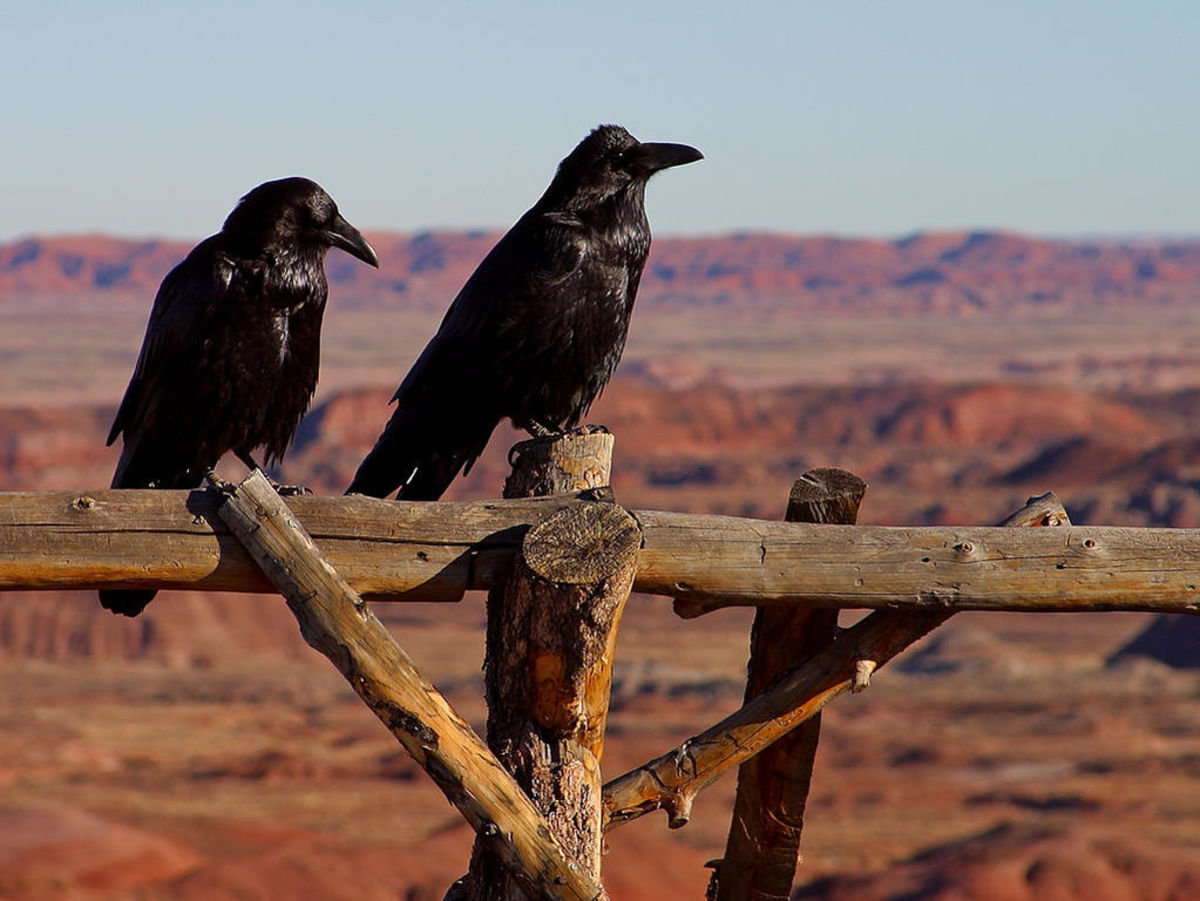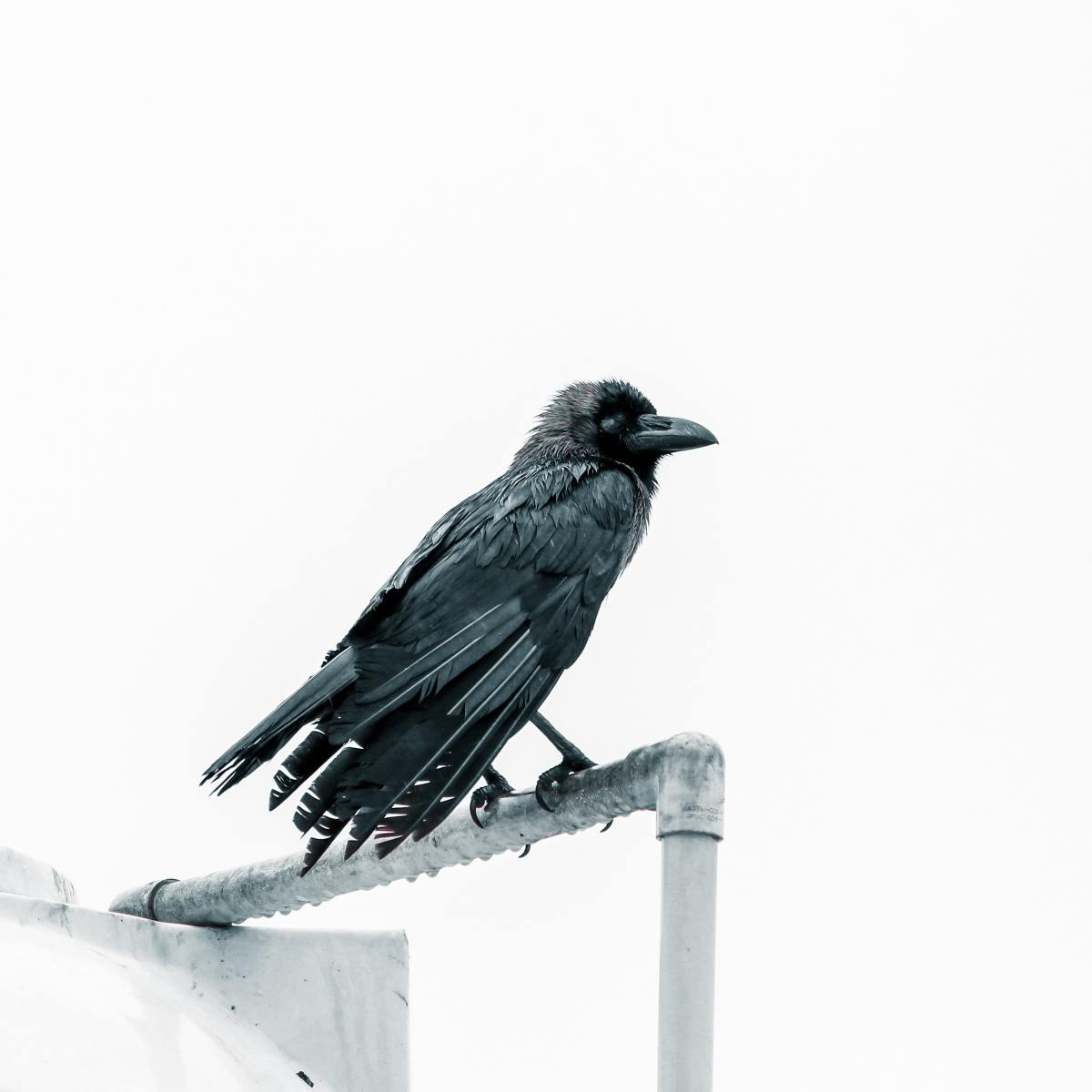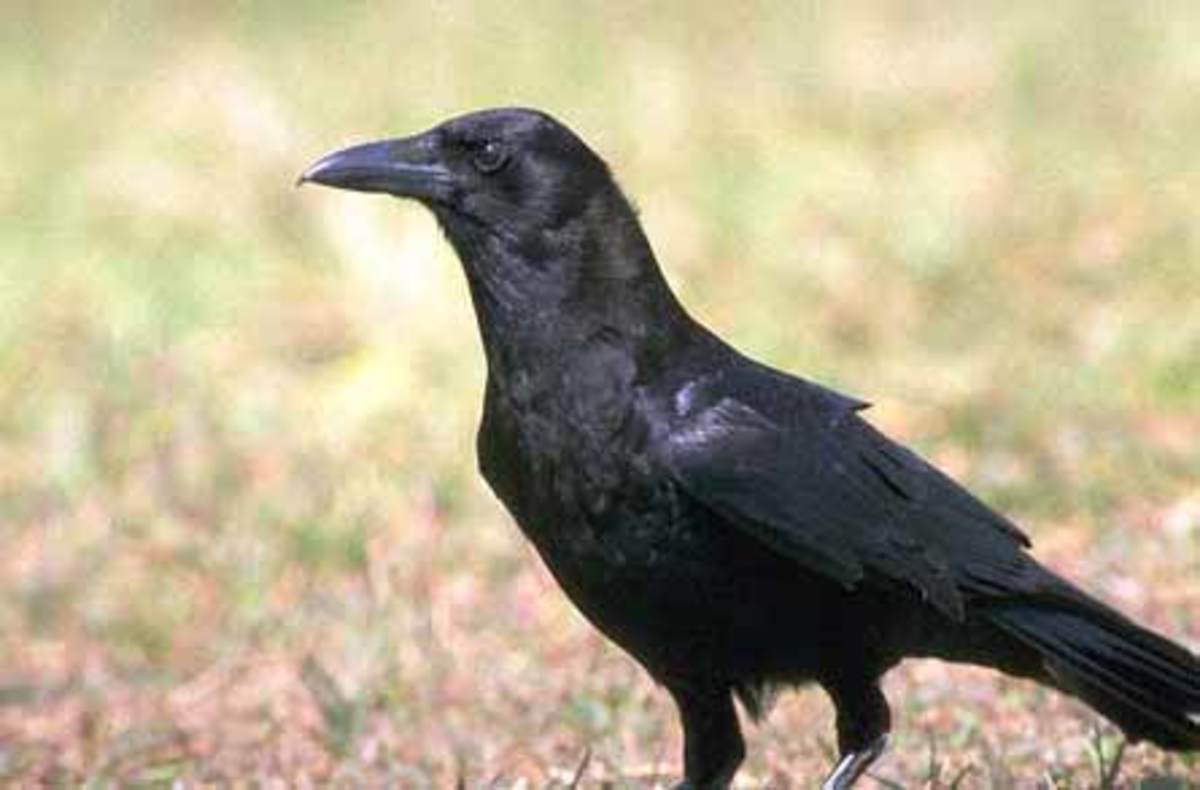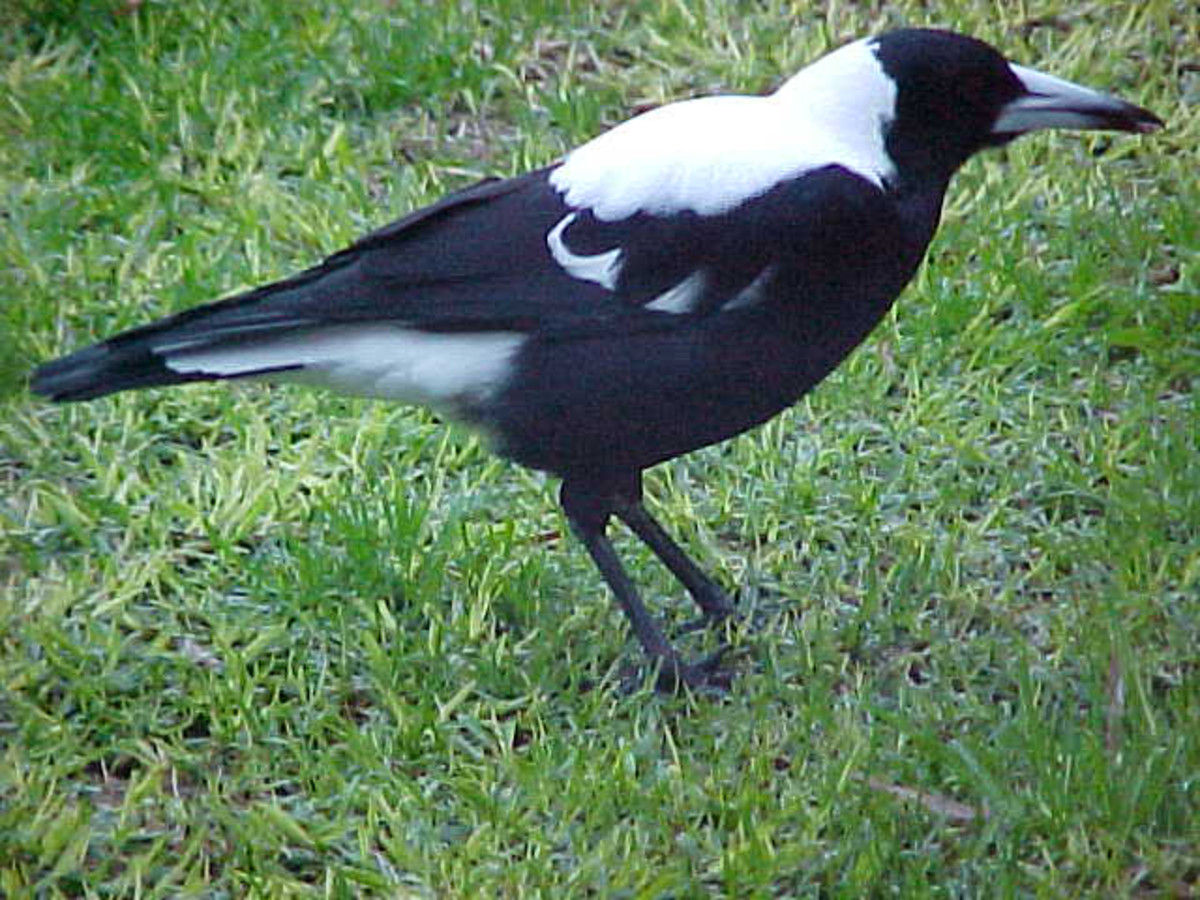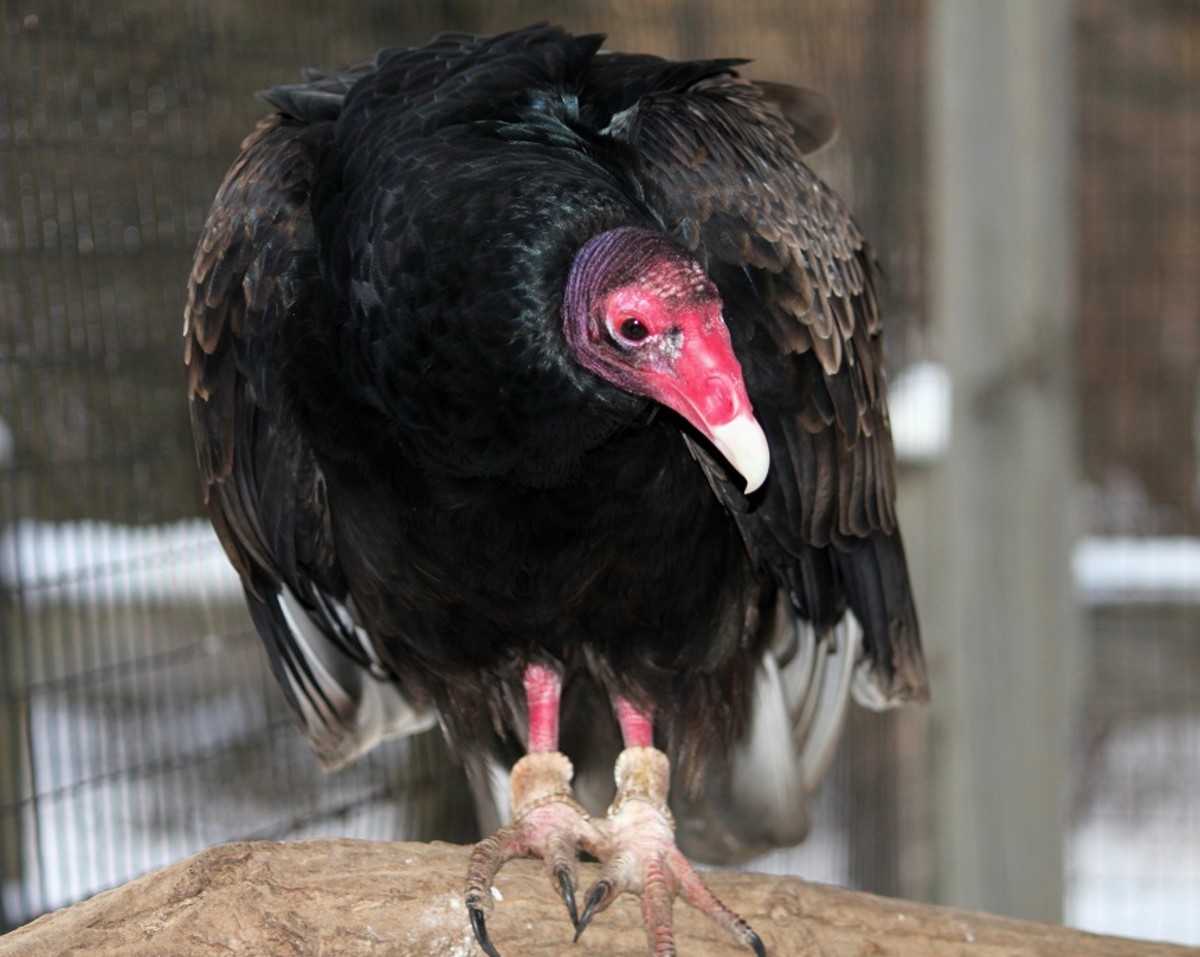Raven the Mystic Animal
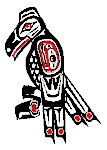
The raven's special mystic
It is argued that in many respects the raven is responsible for society but without being part of it as he said to involved in birth and death.

The Raven is the transformer, trickster and "creator"
Known in legends as the one who released the sun, moon, and stars; discovered man in a clamshell; brought the salmon and the water; and taught man how to fish and hunt.
Raven in Kwaguilth culture is known as the sky messenger of the animal kingdom. The Raven is famous for being a somewhat mischievous glutton. He was always out to please himself and have a good time, but his adventures always ended up bettering mankind.
Since mankind began looking to the animal world for insight about their own place in the universe, crows and ravens (and other members of the Corvidae family) have been credited with a certain spiritual significance. Some cultures saw them as messengers to the gods, others believed they had prophetic powers, and still others worshipped them as the creator of the world. Even today superstitions abound concerning these intelligent and mysterious birds.
Due to their dark color, and the traditional association of death and blackness, it is no surprise that many cultures viewed crows and ravens as intermediaries between us and the afterlife, or associated them with sorrow and dying. In fact, carrion birds were usually the first scavengers on the scene after a death, and feasted on man and beast alike. Their reputation among such peoples was grim one, and many scorned the birds, or cursed their presence.
Among other peoples, however, it was the wit and curiosity these birds displayed which colored their spiritual significance. They were associated with joy and laughter, and a spirit of mischief.
The native tribes of the pacific northwest were among the latter of these two. They called Raven the Great Trickster, and boasted that the creation of mankind was Raven's doing. They also claimed that Raven's tricks brought fire to mankind so they wouldn't freeze in the darkness, that Raven supplied water during a great drought, and that it was Raven who made Salmon for the people to eat. When totem poles were erected to honor the spiritual guardians of these tribes, Raven was a common feature on them. In fact, even today some native tribes make prayers to Raven.
Although the idea of totem spirits originated among native tribes, there are also a number of non-natives who claim Raven as their totem (or who have been claimed by Raven, according to the shamanic understanding of totems). These people believe that Raven watches over them, guides them to new discoveries, and teaches them to appreciate the humor in life.
The idea of Raven as a creator was not unique to native tribes, though. Even in Siberia there were myths and stories told of how Raven created the world. Anywhere these dark birds have overcome challenges and eked out a living in rough or hostile environments, tales have been told about their ingenuity and love of life.
In Australia, where the role of the laughing trickster is filled by the kookaburra, the raven has a slightly different role. There, raven is a bird of sorrows. He takes the sadness from humanity, and flies away with it. The Australian raven's mournful call reflects the burden he carries.
The raven's role in early European history is a little less clear, but it was probably associated with both life and death. Ancient earth religions, who laid the foundation for later orders and practices, were very concerned about fertility, birth and death, and the constant circle of life. Ravens and crows would likely have played some role as they disposed of dead bodies, clearing the way for new life.
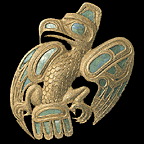
RAVEN is known by many tribes under many names
CHULYEN, HEMASKAS, GUGUYNI, NANKIL'SLAS, KWEKWAXA'WE, KWEKWAXAWE, TXAMSEM, WE-GYET, YHEL
There is more to RAVEN than meets the eye. And how many of you have met the eye of a raven? They've always been associated with Godliness. Few people know that the first bird out of NOAH's ark was a raven. It just didn't return. It didn't feel the need. ODIN relies on his two ravens to fly round the world every day and keep him informed. Edgar Allan Poe's raven shrieked 'Nevermore' but what that has to do with anything only Poe knows.
In the beginning, RAVEN was first and foremost a Creator and Trickster God - especially of the Haida tribe, who claim he discovered the first humans hiding in a clam shell and brought them berries and salmon.
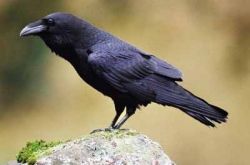
Is this animal a guide for you?
A message from Windhawk on Crows and Ravens
Raven and Crow are both members of the corvid family. Magpies are also cousins. There are a couple of differences which should allow you to differentiate between them. Ravens are larger and their tails are tapered, their call is a throaty "kruk kruk", but they are masters of vocalization and can mimic the calls of other birds and can even be taught to speak in rare cases. Crows are smaller, their tails are straight and their call is the "caw caw" that we all know and love.
That said, many attributes of crow and raven do overlap, however Raven is more associated with Magick, Shapeshifting, and Initiation, where Crow is a messenger of Divine Law.
Raven speaks of the process of death and birth. It guides us to healing, to an initiation that signals the end of one part of life and the beginning of something new. Out of the darkness, out of the Void of Creation we are guided by Raven to become that which we are destined to become. Raven shows us how to shape-shift from one form to another in the process of being reborn to a new integration and a deep healing of old pains and sorrows.
Crow speaks of the creation and magic that is within the world everyday and the laws of the Creator, which are not necessarily the laws of humanity. Crow asks you to allow your personal integrity to guide you, and you will find that you are not alone. Your personal will can then emerge so that you stand in your truth.
Is this animal a guide for you? My sense is: most definitely. That it chooses to manifest itself when you are at your lowest speaks of these totems' shared purpose as a guide out of the Void, out of the darkness to a new life. In order to be initiated, you must find your truth. Listen to the voice of Crow. Listen to the Voice of Raven. Seek for the healing of the emptiness in the discovery of your new destiny.
Whichever corvid appears before you, you are being asked to begin a new path of your own creation. The destiny that you know well but has been hidden beneath deep wounds is seeking to become a living breathing part of your life. Much work is ahead. If you face it with courage and integrity you will not falter. Healing is coming. It will be up to you to welcome its embrace.
Raven Magick: Native American Flute - Blues MAMA Original - Beautiful raven pictures with beautiful native flute music
Magic, Healing, Creation
If a raven totem has come into our life, magic is at play. Raven activates the energy of magic and links it to our will and intention.
With this totem, we can make great changes in our life; the ability to take the unformed thought and make it reality.
The raven shows us how to go into the darkest parts of our inner being and bring out the light of our true self; resolving inner conflicts which have long been buried. This is the deepest power of healing we can possess. Native people from the Americas believed the raven to be the creator of the world and the bringer of light and fire.
Ravens are important in many cultures and harbingers in more than one religion. It is not hard to see why. Anyone who has spent a moment listening or watching must be struck with curiosity at what these aerial acrobats are up to. They are among the most intelligent of bird; social, and talkative, with a complex language that shows regional dialects. Few animals show as much love for their own abilities as these birds. They fly, and they are aware how cool it is they do so. Drifting on a warm updraft, diving through a valley, riding the wind of battered air in storms and fire, wrestling with each other midair, they joyfully exult in their mastery of the sky.
A group of ravens has a few names depending on what they are doing at the time you see them. If they are standing guard over something or appear to be, then they are called a CONSTABLE. If they are lurking in the shadows, apparently up to no good or looking generally spooky they are called a CONSPIRACY. If they are dive-bombing the neighborhood cat or harassing their predator the owl, they are called a TERROR or UNKINDNESS.
The story of "Raven Steals the Sun" - is legendary
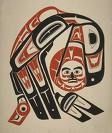
An old man lived in a house on the bank of a river with his only child - a daughter. At this time, it was pitch black everywhere and no one could see anything. So whether she was beautiful or not, there wasn't a way anyone could tell. Thus begins the tale of the Raven and the Sun. It's said that the old man kept the Sun locked in a box inside a box, which had yet another box containing an infinite number of boxes until finally there was one so small that all it could contain was all the light in the universe.
The Raven was not satisfied with the state of darkness since it led to his blundering and bumping into everything. This slowed him down in his pursuit of the good things in life, which was what he loved more than getting into mischief. One day he crashed into the old man's house and he heard the man and his daughter talking about the light. He decided he wanted the light for himself so he waited for the daughter to leave the house. He transformed himself into a pine needle to slip into a bucket of water. When the daughter drank the water and swallowed the pine needle, the Raven transformed himself into a tiny human being inside her. When he emerged, he was a very odd looking child, but it was too dark to noticed his long nose and the few feathers still clinging to him.
As the Raven/Child gained the affection of the old man, he devised a plan to get the Sun. He asked for the largest box in the house and upon being refused, he cried and screamed so loudly that the Grandfather gave him the box. After all it was only one and there were so many more. It took many days, but after a few well-executed tantrums the Raven/Child removed all the boxes. When only a few were left, a strange radiance began to suffuse the room. The Raven/Child begged to hold the light for only a few moments, and even though the Grandfather had come to love the Raven/Child with only a glimpse of him, he gave him the light. As the light was passed to him, the Raven/Child transformed into a huge Raven. He snapped up the light and flew up the smoke hole of the house into the darkness of the world.
The Raven now rejoiced with his new possession and was having such a good time that he did not see the Eagle come upon him. In a panic, he swerved and dropped almost half the light he was carrying. It fell to the rocky ground and broke into pieces. They bounced back into the sky and remain there to this day as the Moon and the Stars.
Meanwhile, the Raven was pursued to the edge of the world and, exhausted, he finally let go of his last piece of light. It fell to the East and that is how the Raven gave us the Sun.
The Raven Totem Guide - http://members.tripod.com/mystinwolf/raventotemguide.html
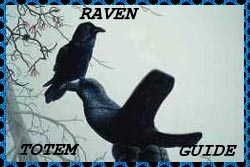
The Raven has been dreaded as a bird of ill fortune; distruction and darkness; but in the spiritual world he is a bird who brings protection. He warns the forces of light of oncoming destruction and battle therefor giving us the power to guard and time for preparation. These destructive forces are a natural and necessary facet of life even though they are painful; but the raven's relationship to the forces of destruction does not mean he is the bringer of the destructive forces yet better considered the messenger.
The Raven brings powerful healing qualities by a process known as the resolutions of opposites. This meaning in darkness there is light; and in light there is darkness- death is necessary for rebirth- destruction is necessary for renewal. There must be death in order to make room for birth. By using this process of resolution of opposites we learn to resolve conflicts that have long lain buried in our unconscience or our past. There must be darkness if we are to emerge into the light. By his association with death he is also associated with depth.
The Raven is a bird of the Underworld; he has the ability to see into the past, the future, and beyond the veil of death. He has the great ability to travel from this world to the next; accessing the darkest regions bringing back visions and oracle instructions for the seeker and the healer. It is believed that the Raven is given as a gift from the Gods for the Seeker and the Healer. This totem guide was one of my biggest battles to accept as I was taken to these dark regions and saw many things in the Underworld that I did not care to see. I fought the Raven's knowledge in the beginning and this created a great fear for me; I prayed not to travel with him as I did not want to know of the destruction and death. I finally accepted the Raven and his gift and have learned to accept all knowledge good or bad. We must not be afraid of the darkness if we are to gain knowledge; take the plunge with the Raven into the dark depths and know that in doing so you are protected.
If you have embraced, accepted, and know Raven; you find affinites with his qualities and energies; an introduction to the Raven at a phase in your life may be an indication that he is urging you to hear his message; To accept destruction or death in your life as an opportunity for renewal or rebirth. Sometimes our lives may go through difficult dark times in order for better and brighter things to come. Our fear of the darkness is worse than anything we may find there.
The Raven and the Whale - An Inuit story that needed to be told
It is the story of vanity, lust, mistakes, forgiveness, life and each of our journeys to death.
Raven finds the first man - There are different stories about how Raven created the world and the first men. Some of them have the Raven forming the first peopl
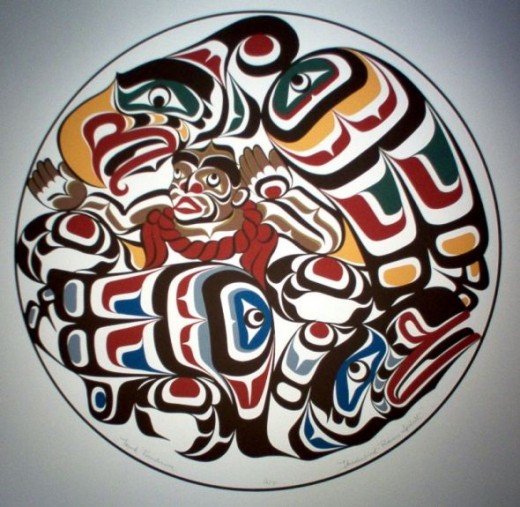
A Raven Tale as told by Eldrbarry
This tale was told among the Haida, and probably other tribes of the Pacific Northwest.
After the great flood had at long last receded, Raven had gorged himself on the delicacies left by the receding water, so for once, perhaps the first time in his life, he wasn't hungry. but his other appetites, his curiosity and the unquenchable itch to meddle and provoke things, to play tricks on the world and its creatures, these remained unsatisfied.
Raven gazed up and down the beach. It was pretty, but lifeless. There was no one about to upset, or play tricks upon. Raven sighed. He crossed his wings behind him and strutted up and down the sand, his shiny head cocked, his sharp eyes and ears alert for any unusual sight or sound. The mountains and sea, the sky now ablaze with the sun by day and the moon and stars he had placed there, it was all pretty, but lifeless. Finally Raven cried out to the empty sky with a loud exasperated cry.
And before the echoes of his cry faded from the shore, he heard a muffled squeak. He looked up and down the beach for its source and saw nothing. He strutted back and and forth, once, twice, three times and still saw nothing. Then he spied a flash of white in the sand.
There, half buried in the sand was a giant clamshell. As his shadow fell upon it, he heard another muffled squeak. Peering down into the opening between the halves of the shell, he saw it was full of tiny creatures, cowering in fear at his shadow.
Raven was delighted. Here was a break in the monotony of the day. But how was he to get the creatures to come out of their shell and play with him? Nothing would happen as long as they stayed inside the giant clamshell.
They were not going to come out as long as they were so afraid of him. So Raven leaned over his head, close to the shell, and with all the cunning and skill of that smooth trickster's tongue, that had so often gotten him in and out of so many misadventures during his troubled and troublesome existence, he coaxed and cajoled and coerced the little creatures to come out and play in his wonderful shiny new world.
As you know the Raven has two voices, one harsh and strident, and the other which he used now, a seductive, bell-like croon which seems to come from the depth of the sea, or out of the cave where winds are born. It is an irresistible sound, one of the loveliest in the world.
It wasn't long before first one and then another of the little shell-dwellers emerged from the shell. Some scurried back when they saw the Raven, but eventually curiosity overcame their caution and all of them had crept or scrambled out.
Very strange creatures they were: two legged like Raven, but otherwise very different. They had no feathers. Nor fur. They had no gret beak. Their skin was pale, and they were naked except for the dark hair upon round, flat-featured heads. Instead of strong wings like raven, they had think stick-like arms that waved and fluttered constantly. They were the first humans.
For a long time Raven amused himself with these new playthings. Laughing as they explored with wonder a much expanded world. Sometimes they helped each other, sometimes they fought over something they had found. Raven even taught them some tricks, but soon he became tired of their ceaseless activity.
For one thing, they were so helpless out in the world. They needed shelter from the sun and the rain. They were so fearful and seemed so small. And there were no girls among them, only boys. Raven was about to shove these tired, demanding and annoying creatures back into their shell and forget them, when, as so often happens with Raven, he had an idea for some fun.
Raven began to search for the girls. For it is the way of things in the world that there are both males and females of every creature. Somewhere there must be girls. Raven searched and searched. Under logs and behind rocks, he looked. But he could not find the hiding place of the first girls.
But as he searched, the tide was going out, and as it reached its lowest, the Raven spotted some giant Chitons clinging to the rocks. These giant shellfish had but one shell, fastened tightly to the rocks with huge soft lips around their edges. Raven pried one loose with his beak. And there inside was a girl. He pried off another, and another, and another in each was a girl. They were very similar to the creatures he had found in the clamshell, but more like the Chiton, softer and rounder, in contrast to the hard shell and strong muscles of the clam. And these were just as frightened of the Raven. He gathered them onto his back with difficulty, and brought them to the boys he had found in the clamshell.
Raven was expecting the boy creatures to be very happy he had found the girl creatures, but to his surprise. They were frightened of them and some even ran back into the Giant clamshell to hide. The girl creatures were just as shy and huddled together watching the males with fearful and curious eyes. Both the boy and girl creatures seemed very modest and sought to cover their bodies with strips of kelp and woven seaweed from the shore.
The boy creatures were astonished and embarrassed and confused by feelings they had never before had. They didn't know how to behave. But some of them overcame their fear and began to do things to attract the attention of the girl creatures Raven had brought. Some began to show off the tricks they had been taught - leaping and running and wrestling with other boy creatures. Some of the girls creatures overcame their shyness, first with quick glances then finally allowing the boy creatures to approach them, and even leaving the safety of their huddled group of girl creatures. Gradually the two groups began to mingle into one and just as gradually the boy creatures and girl creatures overcame all their fears and paired off, walking hand in hand, their eyes absorbed in each other totally.
Raven watched all this with increasing interest and surprise. Among all the creatures of the world, there were few whose males and females were so very different. The males proud, agile and strong, the females gentle, soft and tender. Sometimes the males would be too rough in their play with the females and there would be tears. But those same tears seemed to have an emotional power over the males bringing out out of them protective instincts. The strengths of each balanced the weakness of each.
And since that day, Raven has never been bored. In fact, at times he has almost regreted bringing the first men and women together. From the strong muscles of the clam and the soft lips of the Chiton, from the pairing of these first people came the first families. Children were born, some strong and male, some soft and female. Many generations have been born, have grown and flourished, have built and created or fought and destroyed. Many have blamed the Raven for playing a terrible joke on humanity, for often men and women just barely get along, but somehow from this strange combination of reason and intuition, of muscle and emotion arose that which was needed for the race to survive the storms of life on the shores.
Raven himself felt strange protective urges for these first people. Though a glutton and trickster by nature, he would again and again provide for these creatures he found in the clamshell. In time he would bring them the Sun, Moon and Stars; Fire; Salmon and Cedar, teach them the secrets of hunting, and the world. Raven would watch these weak creatures become both strong and loving, courageous and compassionate, able to fend for themselves and survive.
And their children were no timid shell-dwellers, but they continued to be children of the wild coast, of the stormy shores between the land and the sea. They challenged the strength of the stormy north Pacific wresting their livelihoods from the sea even as they made their homes on its shores.
This carving of Raven was carved by Bill Reid. It portrays the story of how Raven coaxed the first men out of a giant clam shell
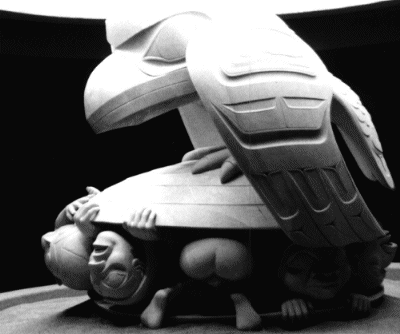
The Raven by Edgar Alan Poe - Animated Narration
"The Raven" is a narrative poem by the American writer and poet Edgar Allan Poe. It was published for the first time on January 29, 1845.
Terrance Henry Booth, Jr.: Tsimshian Art - Raven The Sun Guardian
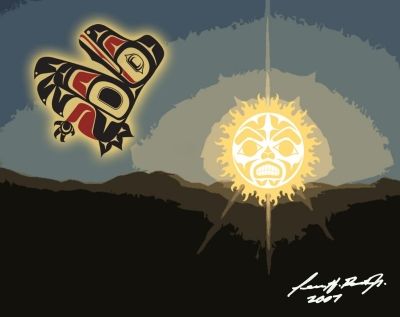
Genius Bird - From National Geographics
An ornithologist devises a test to see how clever ravens really are.
Raven Episodes
Long recognized as one of the most intelligent birds, the raven also has a less than savory image throughout history as a scavenger that does not discriminate between humans and animals.
Ingenious and versatile, ravens are members of the crow family, which includes jays and magpies. They are found everywhere in the northern hemisphere and adapt to very different terrain, from deserts to mountains — a feat requiring high intelligence.
They learn to find food even in the harshest conditions, such as the dead of winter in Yellowstone National Park. As scavengers, ravens know how and when to take advantage of other animals to help them cadge a meal they couldn’t otherwise reach. In Yellowstone, bison that don’t survive the harsh winter attract coyotes, whose sharp teeth and strong jaws rip open the tough, frozen hides — making the meat accessible to watchful ravens. They also have been seen following wild wolf packs to a kill; some stories even have ravens flying ahead of the wolves to lead them to prey.
- Ravens
NATURE's Ravens explores how these all-black creatures acquired their dual and contradictory images - as birds of both life and death.
The Kermode, or "Spirit Bear." Raven changed every tenth black bear white in order to remind all that the earth was once covered
